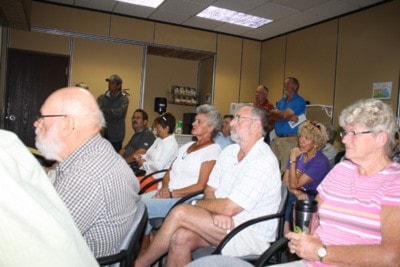The regional district board had an agenda heavy on water issues in the Twin Lakes watershed at the regional district board meeting on September 20.
The board heard from a delegation fronted by Twin Lakes resident Coral Brown, who came well prepared with a presentation describing the Twin Lakes aquifer. Brown concluded by asking the board to place a moratorium on large scale development until sufficient data could be compiled on the aquifer to prove that it could support such water useage.
Brown’s presentation to the board was nothing new to the directors, who have discussed water issues surrounding the Twin Lakes aquifer for several years. A massive development proposed by Suki Sekhon, owner of the Twin Lakes Golf Course, could see more than 250 dwelling units constructed on a high ridge just north of the course. Many of the 250 residences already distributed across the acquifer fear that the development will be unsustainable.
Brown also presented a 185 name petition to the board in support of a request for a moratorium on development. An observation well was drilled on the golf course late in 2011, and Brown felt that the regional district needed to assess the well for a number of years in order to properly assess the data.
Summerland Director Janice Perrino asked why the delegation chose to appear before the board.
“Nothing is being done, and we feel we are being misunderstood because we’re a ground water limited area, we feel that it’s always looked at that there’s land for development, but there is no water, there is no extra water for development, and we want people to understand that, but we’ve had a hard time doing that,” Brown answered.
Penticton Director Gary Litke asked if the Lower Nipit Improvement District had considered water storage, to which Brown answered that Horn Lake had been considered, as an old dam was still in existance on the lake, that could provide an additional 380 acre feet of water, as it had done in the past.
Litke also asked about the “best water practices” of the golf course in the past three years, to which Brown answered, “We’ve observed a new owner for five years, and we still see, especially in the lower nine where sprinklers are not on automatic irrigation, all day watering.”
Area “D” Director Tom Siddon noted that the question of storage really meant whether you could provide a buffer between wet and dry years, noting that a reservoir may result in no net gain.
Siddon also spoke to Brown’s comment that “nothing was being done” noting that the provincial approving officer had turned down the development application last year. He said that the board did not have approving authority, and the only regulation the RDOS had involved the subdivision servicing bylaw, which set the limit of useage per household, but did not deal with where the water came from.
Naramata Director Karla Kozakavich observed the large gallery, assembled mostly of Twin Lakes residents, saying she was impressed with the resident output for the issue.
Osoyoos Director Stu Wells also indicated his support for the group, noting that the same people had been to the board room before.
